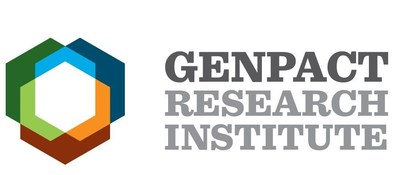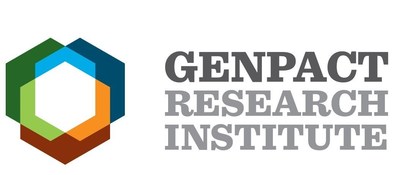NEW YORK, March 22, 2016 /PRNewswire/ -- The Genpact Research Institute today announced the latest findings of its Volatility and Adaptation Index (VAI) which shows that enterprises continued to face lower volatility levels during 2015, as compared to the highs from 2013.

The VAI is based on data from a three-year ongoing study of more than 800 companies across multiple industries that monitors and analyzes large data sets for volatility events, such as changes in the industry, regulatory landscape, or financial environment, as well as related adaptation measures, including acquisitions or geographic expansions, corporate restructuring, and leadership changes. The VAI examines data over 36 months, through January 31, 2016.
Despite a downward trend, which is the lowest in three years, 42 percent of companies monitored still reported at least one volatility or adaptation event in 2015. However, 28 percent showed fewer indicators when compared to the trailing 12-month average.
Results reveal a disconnect between enterprises' volatility and adaptation responses, and uncertainty and risk expectations highlighted by many economists and reflected in today's jittery capital markets. Although the global economy remains somewhat unstable, the index's continued decline indicates that volatility at companies does not always correlate to marketplace fears.
Leadership changes, financial pressures, and mergers and acquisitions (M&A) activity accounted for much of the changes in the 2015 results:
- Financial pressures more than doubled in 2015 compared to 2014.
- M&A activity increased in 2015 by 15 percent compared to 2014.
- Corporate restructurings declined by 80 percent year over year; however, increased 46 percent during the last three months of 2015.
Industry Triggers Vary
Triggers of enterprise volatility and resulting adaptation responses vary sharply across industries, with consumer goods and life sciences showing the sharpest increases. Sector findings include:
- Financial conditions and leadership changes are the top two drivers of enterprise volatility and adaptation for consumer goods companies.
- Leadership churn in life sciences rose dramatically compared to 2014.
- Retail banking and capital markets remain volatile but much less so than prior years; financial conditions, regulatory pressures, and leadership changes are the top drivers.
- High tech and manufacturing had the largest reduction in volatility and adaptation.
"Enterprise transformation typically occurs when the economy is neither too weak nor too strong. In the former, companies freeze into short-term reaction. In the latter, many simply lack the incentive," said Gianni Giacomelli, senior vice president and head of the Genpact Research Institute. "The current situation is peculiar in that the macro outlook is bleak, and technology's rate of change is the strongest in many years; however, we don't see many businesses announcing big changes to leap ahead to prepare for disruption. One possibility is that most C-suite executives still prefer tried and tested actions, like returning cash to shareholders, instead of embarking more wholeheartedly on digital transformation."
The Genpact Research Institute is the research arm of Genpact (NYSE: G), a global leader in digitally-powered business process management and services, which also corroborates the data with in-depth analysis of its client engagements in the industries studied.The 2015 full report is available at http://www.genpact.com/docs/default-source/resource-/genpact-volatility-and-adaptation-index-vai-2015_report.
About the Study:
In early 2013, the Genpact Research Institute launched the Volatility and Adaptation Index as a pulse study to analyze how unprecedented economic volatility leads global companies to adapt, often through transformed business operations. The VAI provides senior leaders with the intelligence to inform structural decisions and facilitate organizational alignment. Updated each quarter, the index examines more than 800 companies in various industries, and monitors large data sets for volatility events, such as changes in the industry, regulatory landscape, or financial environment, as well as related adaptation measures, including acquisitions or geographic expansions, corporate restructuring, and leadership changes. Using sophisticated analytics, the Genpact Research Institute monitors online media, newswires, publications, financial statements, databases, social channels, and other sources to determine and analyze company events, and filters the news and information by relevance and salience. Sector scores are computed by combining the average number of volatility events with the percentage of companies displaying those events. The overall VAI score is created through a weighted average of each of the sector scores.
About the Genpact Research Institute:
The Genpact Research Institute is a specialized think tank harnessing the collective intelligence of Genpact – as the leading business process services provider worldwide – its ecosystem of clients and partners, and thousands of process operations experts. The Institute examines new trends that influence the evolution of strategically important operating models, helping our client's business. It covers 11 strategic needs – from managing regulations and risk, to enhancing profitability, growth, and customer satisfaction – across nine industries. The Institute combines Genpact's deep expertise in process management, analytics, and technology with the insights of our research partners and clients. It oversees external collaborations such as one with MIT Center for Collective Intelligence, as well as the engagement of experts sourced through ProcessColab, Genpact's proprietary operations solutions marketplace. Projects are led by leaders and subject matter experts from Genpact's offices around the world. These teams also draw on a global network of external partners and industry experts, and benefit from our extensive connection with hundreds of large clients globally. For more information, see http://www.genpact.com/home/about-us/research-institute.
About Genpact
Genpact (NYSE: G) stands for "generating business impact." We are a global leader in digitally-powered business process management and services. We architect the Lean DigitalSM enterprise through our patented Smart Enterprise Processes (SEPSM) framework that reimagines our clients' operating model end-to-end, including the middle and back offices. This creates Intelligent OperationsSM that we help design, transform, and run. The impact on our clients is a high return on transformation investments through growth, efficiency, and business agility. For two decades, first as a General Electric division and later as an independent company, we have been passionately serving our clients. Today, we generate impact for a few hundred strategic clients, including approximately one-fifth of the Fortune Global 500, and have grown to over 70,000 people in 25 countries, with key offices in New York City. The resulting business process and industry domain expertise and experience running complex operations are a unique heritage and focus that help us drive the best choices across technology, analytics, and organizational design. For additional information, visit www.genpact.com. Follow Genpact on Twitter, Facebook, LinkedIn, and YouTube.
For more information:
|
Danielle D'Angelo (Genpact Media Relations) +1 914-336-7951 |
Abby Trexler (for Genpact) +1 212-931-6179 |
Archie Pottinger (For Genpact Europe) + 44 (0)20-7680-7113 |
Logo - http://photos.prnewswire.com/prnh/20160321/346273LOGO
To view the original version on PR Newswire, visit:http://www.prnewswire.com/news-releases/enterprise-volatility-at-lowest-point-in-three-years-as-some-industries-adaptation-picks-up-says-genpact-research-institute-300238897.html
SOURCE Genpact Research Institute


